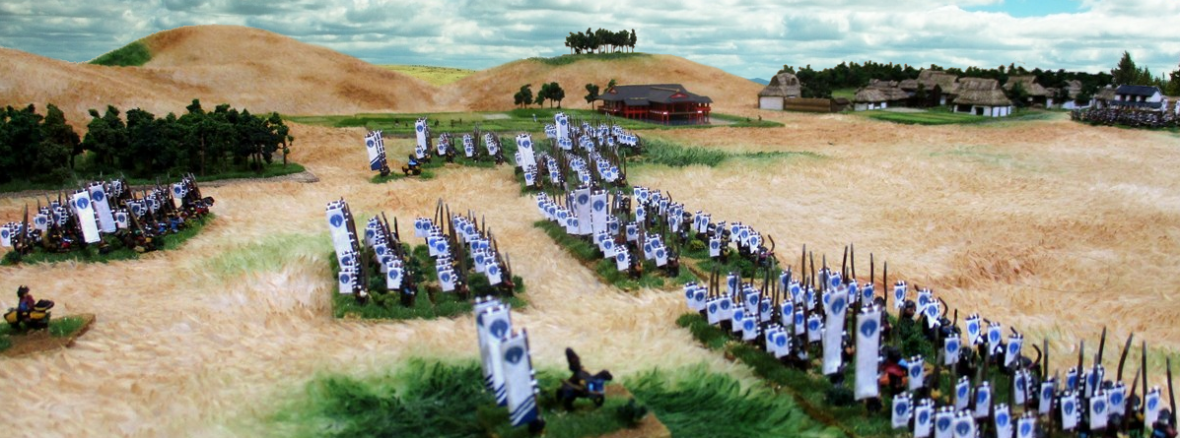Oda Nobunaga has a reputation in the West for tyranny and ruthlessness bordering on the psychopathic, his vassals kept in line by a reign of terror. Such portrayals can reach levels of rather grotesque caricature, as in the recent Netflix ‘documentary’ series. A recent podcast covering the settling of the struggle between Toyotomi Hideyoshi and… Continue reading Nobunaga the Tyrant?
Category: History
The Saika-shū and ‘Kumi-uchi’
I briefly mentioned the Saika-shū before when I made a base of them for Tenka Fubu. They were an independent armed group in Kii province, particularly noted for their use of guns. Kii province was nominally governed by the Hatakeyama clan, but in reality they had little influence. In the absence of a strong central… Continue reading The Saika-shū and ‘Kumi-uchi’
The Attack on Ishida Mitsunari
One of the many incidents associated with the Sekigahara campaign is the attack on Ishida Mitsunari by members of the so-called ‘bushō’ faction’ led by Katō Kiyomasa and Kuroda Nagamasa. The story goes that they attempted to kill Mitsunari in Ōsaka out of a grudge originating from the war in Korea. Mitsunari fled Ōsaka and… Continue reading The Attack on Ishida Mitsunari
Social Class and Organisation by Weapon Type
One of the objections to the idea of troops being taken away from their feudal lord and re-constituted into units of the same weapon type is that it breaks the feudal relationship (shujūkankei) that those troops have with the person who raised them. That is, warriors who bring retainers to the battlefield are not going… Continue reading Social Class and Organisation by Weapon Type
Mercenaries and ‘Randori’
Alongside the feudal framework of Sengoku armies were others from outside this framework. These were mercenaries, fighting for plunder, or in the hope of reward. As is usually the case with the Sengoku, they could come from a variety of backgrounds. Some people were driven by desperation due to famine or other natural disaster to… Continue reading Mercenaries and ‘Randori’
Who Were The Ashigaru?
I talked a bit about the background of the ashigaru in a previous post on the campaign year. I thought I’d flesh out the research a bit. There’s a common misconception that the ashigaru were ‘conscripted peasants,’ meaning poor farmers. This would mean that military campaigns would be constrained by the agricultural year, as a… Continue reading Who Were The Ashigaru?
The many theories of Honnō-Ji
(Non-wargaming post) Later this year, Kitano Takeshi (aka ‘Beat’ Takeshi) is releasing a film based on the Honnō-Ji incident. Takeshi is a cult figure in Japan, but in the West he is probably best known as the eponymous lord of ‘Takeshi’s Castle’ in the greatest game show in television history. The story is based on… Continue reading The many theories of Honnō-Ji
The case against weapons groups
Having covered previously the theory of when and how Sengoku Jidai armies came to be organised by weapon groups, I thought I’d go over the counter-arguments, in particular a different interpretation of the famous Iwatsuki document. First, it’s worth noting that in academia the ‘orthodox’ position is that Sengoku armies were organised by feudal lord… Continue reading The case against weapons groups
Sekigahara: An alternative deployment
I was recently brought back to looking at Sekigahara. I normally don’t bother with Sekigahara that much as it happens 10 years after the Sengoku Jidai finishes..... But the stimulus was painting a couple of figures in 28mm by Zenit/Kensei of Ishida Mitsunari and Ōtani Yoshitsugu. These figures were part of a Kickstarter from a… Continue reading Sekigahara: An alternative deployment
Guns, shot and powder
I recently came across an article by historian Hirayama Yū, contrasting the usage of guns at Nagashino by the Oda and Takeda. The upshot of his thesis is that the Oda advantage in guns was not just in the quantity of the weapons themselves, but also in the quantity of shot and gunpowder. Simply put,… Continue reading Guns, shot and powder
